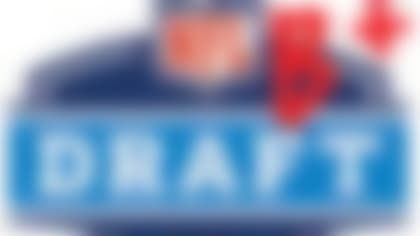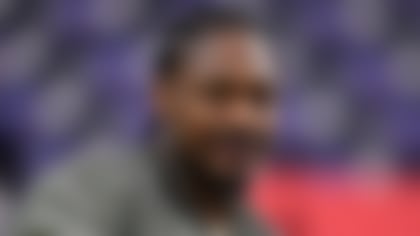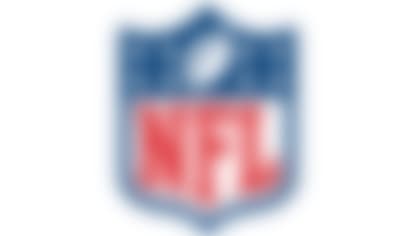If there was one thing that surprised, even shocked, new Jacksonville Jaguars general manager David Caldwell about the biggest night of his professional career, it was probably the emotion involved.
2013 NFL Draft grades by division

The draft is finally behind us. How did everybody do? Bucky Brooks breaks out the red pen and grades all 32 teams by division. **More ...**
Or, more specifically, that there was none to speak of as the seconds ticked down and the second overall pick approached.
"I've always been really nervous on draft day, during my time in Indianapolis, my time in Atlanta," Caldwell said from the team facility on Wednesday. "So what surprised me was there was a calmness here. I remember thinking, in Indy and Atlanta, 'Man, I hope this guy or that guy falls.' I guess it's like being a player. When you're in the game, you're just reacting and doing it. When you're on the sideline, you're more stressed."
Don't mix this part up: There was indeed pressure on Caldwell, as well as new head coach Gus Bradley and the rest of the regime hand-picked by neophyte owner Shahid Khan.
Caldwell's staff had been building to last weekend since the day he went on the clock back in January, taking the GM gig in Jacksonville after rising through the ranks with the Carolina Panthers, Indianapolis Colts and Atlanta Falcons. With the 2013 NFL Draft in mind, the Jaguars sidestepped big-ticket (even mid-level) free agents and significant trade scenarios. One of the attractions to Jacksonville for Caldwell, who turned down the New York Jets to come to this historically nondescript franchise, was the ability to start with a blank slate. And he wanted to maintain every inch of that flexibility into the end of April.
Having hoarded all of his chips in that matter, this was always going to be an important time. And the calm? It came from the rational and logical process the team took to arrive at the eight draft picks and 24 rookie free agents who will be at the club's minicamp this weekend.
Harrison: Post-draft Power Rankings
After the 2013 NFL Draft, Elliot Harrison updates his Power Rankings, with plenty of teams moving up and down the board. **More ...**
"I just feel a lot better about our team now; we could line up and play a game tomorrow if we had to," Caldwell said. "I feel good about the youth and speed we added. Those eight guys, they love football, they're highly competitive, and that's what we're going to here. The one thing Coach Bradley has preached is competitiveness. They'll have to compete every day here, all the players, and they're aware of the situation. They know the only thing they'll get is a chance to compete."
The way the Jaguars arrived at the eight names called in Radio City Music Hall was far less abstract than the cauldron of competition -- a Pete Carroll ethos Bradley brings from Seattle -- those rookies will be tossed into.
Jacksonville has thrust itself into the forefront of the burgeoning football analytics community, an effort spearheaded by Khan's son, Tony, the club's senior vice president of football technology and analytics, and his right-hand men Daniel Adler (director of football research) and Mike Stoeber (assistant director of football technology).
The work toward the 2013 draft was a convergence between that and the conventional know-how of a personnel staff led by Caldwell, who worked his way from scouting assistant to area scout to regional scout to college scouting director to director of player personnel with his three prior clubs. To that end, Caldwell, Bradley and Tony Khan blanketed the country together in March and April, hitting pro days and conducting on-campus workouts, while examining every bit of hard data they could find.
The selection of No. 2 overall pick Luke Joeckel mined both old-school and new-school research. Caldwell cited the former Texas A&M standout's makeup, his background, his competitiveness, and the fact that he routinely faced top pass rushers -- not only in both Big 12 and SEC play, but also in practice against Von Miller and Damontre Moore at A&M. Tony Khan, meanwhile, had data revealing that Blaine Gabbert was actually in the top third of NFL quarterbacks when given at least 2.6 seconds to throw.
"Some of the studies Tony did helped us come to the conclusion that taking an offensive tackle (with the second pick) was a good route to go," Caldwell said. "He had the passer rating broken down from where the quarterback had 2.6 seconds to throw to 2.5, the amount of pressure, the sacks we gave up, third-most in the league last year. We used a lot of the stuff Tony put together. ... It's part of the process, not the whole process. Maybe we miss something, but we're trying not to."
While the Jaguars already had one talented offensive tackle in Eugene Monroe (whom Caldwell called a "top-10 tackle"), both schools of thought supported drafting another. Caldwell emphasized the rising importance of the right tackle in a league where defensive coordinators are becoming more varied and creative in exploiting weaknesses, and Khan turned to a ProFootballFocus.com study compiled by Steve Palazzolo showing the right tackle had become just as vital as the left tackle.
All of that cemented Joeckel, over eventual No. 1 pick Eric Fisher, as the top player on Jacksonville's board, and also led to the decision, two weeks before the draft, that the Jaguars were taking whichever tackle the Kansas City Chiefs didn't.
"What we did was fill a need where the value met the need," Caldwell said. "It became clear two weeks prior, after we met with the scouting staff, the personnel staff, got their feedback, that the two highest-rated guys were the tackles. The coaches told us we needed to upgrade the line. So this was gonna be a solid pick; we felt we'd get a cornerstone, a pillar for the team."
Casserly: Draft steals on each day

Which players are bound to outperform their draft slots? Charley Casserly identifies 10 value picks to keep an eye on. **More ...**
Part of it, too, was the position itself. According to Khan's data, 71 percent of tackles drafted in the top 10 from 1995 to 2008 have made at least one Pro Bowl, while only 16 percent of tackles drafted between 11 and 32 over that period did the same. Also, top-10 tackles drafted from 1990 to 2008 averaged a staggering 70.5 starts in their first five years, a number that dipped to 58.5 starts for those drafted from 11 to 32.
The analytics also helped later in the draft. The Jags identified safety Josh Evans as undervalued -- a Round 2/3-type who gave up a completion percentage of just 35.0 last year at Florida -- and got him in the sixth round. They saw Tobais Palmer the same way -- a player who averaged 25.7 yards per kick return and caught 66 percent of the passes thrown at him by a 57 percent passer (N.C. State's Mike Glennon) -- and signed him as an undrafted free agent.
In every case, the tape had to match up with the numbers, and it's not like the stats were infallible.
Before the second round, in which Jacksonville held the first pick, the Jaguars had John Cyprien, Zach Ertz and Darius Slay atop their board. With three teams inquiring about a potential trade-up, Jacksonville ran the numbers on the probability one of those guys would be left in the 40s. Statistics showed it was likely. But Caldwell decided he liked Cyprien too much to risk losing him and took the Florida International safety with the No. 33 pick. The other two players were gone by 36.
And then, there were spots, like quarterback, where the GM simply went on his feel for the roster.
"We worked out five or six quarterbacks, spent time with them," Caldwell said. "And we'd evaluated what we had in Blaine and Chad (Henne), and we felt like the important thing was to solidify the roster first. We do that, get some help around them, and give them a fair shot to play well. And we really felt like -- with our first-, second-, third-, fourth-round picks -- we got incrementally better at those positions. We weren't 100 percent sure we'd get better at the quarterback position with guys at those spots."
The Jaguars left New York with a tackle, five defensive backs and two versatile offensive playmakers. Caldwell said the biggest goal was to "take advantage of drafting first or second in every round," something he thinks the team did, and something he hopes the club will not have to do again for a while.
And that moves things to the next step. The Jaguars have plenty left to sort through. Justin Blackmon's four-game suspension and future with the team -- Caldwell wouldn't comment, other than to say he and Bradley are "prepared for every situation" -- must be assessed. So too will the overall state of the roster, with the coaches and personnel folks getting their first on-field look at the players.
"Our mindset," Caldwell said, "is to just continue to get better."
Whether or not they improved over the three days of the draft is an open question, as it is with the 31 other teams.
But there's a reason why Caldwell was so calm amid such an uncertain process. Instead of worrying and waiting and hoping, like the proverbial player on the sideline, he was reacting and doing. And in the end, he knew there wasn't much else the new Jaguars regime could've done to make this debut a big one.
Follow Albert Breer on Twitter @AlbertBreer.



